Four very old plants: Gosslingia, Sawdonia,
Drepanophycus and Zosterophyllum
Plants from the Early Devonian (410 - 380 million years ago) didn't
grow very high. They didn't get much taller than 50 cm. Yet they were much
more complicated than Silurian plants, like Cooksonia. The latter
plant was mostly much shorter than 10 cm, didn't have leaves, was bifurcating
and bore sporangia at the top of the little stems. The plants presented here
showed already much more differentiation.
Devonian plants are usually only fragmentarily preserved. This is on the
one hand a consequence of the age and on the other hand because
the circumstances for fossilisation were unfavourable. And even if somewhere
many plant remains are found, they are generally heavily damaged. This is
certainly the case for the first plant below. |
Gosslingia breconensis
This plant is found in several places in the world, but it was described
by Heard in 1927as a result of finds in a quarry in the Brecon Beacons (Wales):
this explains the species name. In 1970 Prof. Dianne Edwards of the Cardiff
University described it again very extensively.
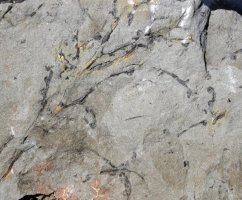 My wife
and I have visited this quarry several times and we found out that there
are vast amounts of plant remains, but hardly any pieces with structure,
like branchings or sporangia. Most of the remains are thin stems with a maximum
length of 20 cm. Often they are embedded more or less parallel which
is an indication for flowing water during the sedimentation. My wife
and I have visited this quarry several times and we found out that there
are vast amounts of plant remains, but hardly any pieces with structure,
like branchings or sporangia. Most of the remains are thin stems with a maximum
length of 20 cm. Often they are embedded more or less parallel which
is an indication for flowing water during the sedimentation.
Still we found some branched stems and also a couple of coiled tips.
But the most wanted sporangia, which are of vital importance for identifying
Devonian plants, remained hidden.
When I went through the crates with fossils from the quarry again, some
big slabs appeared which I had taken along because they looked promising.
From these slabs two very fine specimens appeared, showing bifurcations,
sporangia and coiled tips.
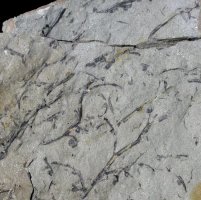 Click on the
photo on the left to see a reconstruction and a photo of one of these plants.
Click on the right hand one to see the other specimen. The quality is not
comparable to the preservation of e.g. plants from the Coal Measures but
by Lower Devonian standards the fossil is very complete. The sporangia are
clearly visible along the stems and also some curled tips (a characteristic
of many primitive plants) are present. Click on the
photo on the left to see a reconstruction and a photo of one of these plants.
Click on the right hand one to see the other specimen. The quality is not
comparable to the preservation of e.g. plants from the Coal Measures but
by Lower Devonian standards the fossil is very complete. The sporangia are
clearly visible along the stems and also some curled tips (a characteristic
of many primitive plants) are present.
The stems branched bifurcating with alternately a left hand branch being
thicker and a right hand branch being thicker. In this way a kind of main
stem came into existence. This kind of branching is called 'pseudomonopodial'.
It can be regarded as a transitional stage between bifurcating (like
Cooksonia) and a main axis with side branches.
As far as I know only less complete fossils of this plant have been
found at other sites (e.g. in Belgium).The age of the plants is Siegenian
(about 400 million years). |
Sawdonia ornata
I saw this plant for the first time in an abandoned quarry near Glasgow.
Nowadays it is a protected area, but at the time it (luckily) wasn't yet.
The quarry was very wet and overgrown, but there was still a vertical face
where the rock was accessible. This face was crumbling off under the plentiful
rain, causing pieces of sandstone regularly to fall down. In these soaked
fragments were black stems with spines. These turned out to be stems of the
species Sawdonia ornata.
This is also a fossil with a history. Dawson named the plant in 1871
Psilophyton princeps var. ornata because he regarded it as
a spiny form of Psilophyton princeps. The latter plant bears sporangia
in pairs at the end of the stems. Later on it was found out that the sporangia
of the spiny plant were not terminal, but that they were placed
laterally at the side of a stem (as a loose spike). Then in 1971 Hueber placed
the plant into a new genus and he named the plant: Sawdonia
ornata.
Click on the photo to see a reconstruction and a photo.
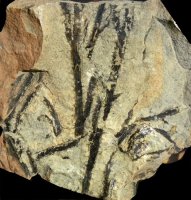
The function of the spines is not clear. They could have had a repelling
task against arthropods, which were already present at the time. It is also
possible that the plants could hold dew with the spines.
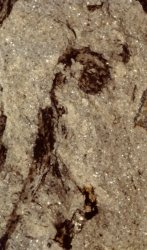 The tips of the stems,
the growing points, were coiled. In between the fossils of the spiny axes
such spirals are sometimes found. They have not yet been found attached to
a stem, but the cell structure of the cuticle, the waxlike layer which
protects the plant, proves that they certainly belong to this species. The tips of the stems,
the growing points, were coiled. In between the fossils of the spiny axes
such spirals are sometimes found. They have not yet been found attached to
a stem, but the cell structure of the cuticle, the waxlike layer which
protects the plant, proves that they certainly belong to this species.
Sporangia of this plant are very rare: Rayner (1983) wrote that in this
quarry only four specimens of Sawdonia ornata with sporangia had been
found. After reading this I have worked through my crates with fossils again
and the first specimen I took in my hands turned out to be such a typical
spike: a stem with black spots alternating left and right of the stem.
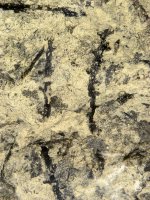 Click
on the photo on the left. The preservation is not very good, but the same
can be said of the plants of Rayner. In spite of the fast find I had no more
specimens in my crates. Click
on the photo on the left. The preservation is not very good, but the same
can be said of the plants of Rayner. In spite of the fast find I had no more
specimens in my crates.
The sporangia are round or oval and are placed, like the side axes,
alternating on the main axis. The bad preservation is likely to be due to
the coarse basic material of the sandstone of the quarry.
Sawdonia ornata is also found in many other places, but not often
as complete as in this one. The age is Emsian (395 million years).
|
Drepanophycus spinaeformis
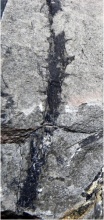 This
is also a spiny plant, like Sawdonia, but yet there is a difference.
In Drepanophycus the spines are called leaves. This is because a vascular
bundle is running through. Also the 'spines' do have a different shape compared
with those of Sawdonia: they are broad at the base and are tapering
to the apex and often they are somewhat bent (more or les sickle-shaped).
They can reach a length of 2 cm, but the average size is 1 cm. Click on the
photo on the right to see a larger photo and a reconstruction of the
plant. This
is also a spiny plant, like Sawdonia, but yet there is a difference.
In Drepanophycus the spines are called leaves. This is because a vascular
bundle is running through. Also the 'spines' do have a different shape compared
with those of Sawdonia: they are broad at the base and are tapering
to the apex and often they are somewhat bent (more or les sickle-shaped).
They can reach a length of 2 cm, but the average size is 1 cm. Click on the
photo on the right to see a larger photo and a reconstruction of the
plant.
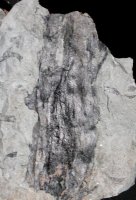 Unfortunately
the leaflets are missing in most cases. This has to do with the
circumstances during the process of fossilization. At some sites,
like in New Brunswick in Canada, near Dave in Belgium and in the quarry near
Glasgow mentioned before, better and more complete specimens have been found. Unfortunately
the leaflets are missing in most cases. This has to do with the
circumstances during the process of fossilization. At some sites,
like in New Brunswick in Canada, near Dave in Belgium and in the quarry near
Glasgow mentioned before, better and more complete specimens have been found.
Fossils with sporangia, however, are extremely scarce.
We have found Drepanophycus spinaeformis at several places in
Belgium, Great Britain and Germany, but in most cases it was only the main
axis without leaflets. This axis can be recognized by its diameter (up to
4 cm) and by its irregular, bubbled surface (click on the photo on the left).
In fact there are no other plants from the Lower Devonian showing these
characteristics. When the axes are thinner, confusion with Sawdonia
is very likely. In that case attached spines, if any, must give clarification.
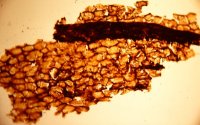 The
sporangia are attached with a small stalk directly to the axis. Finding,
however, a specimen with sporangia is like winning a jackpot in a lottery.
Still we have won a smaller prize in the Glasgow quarry, namely a piece of
the cuticle of the plant. After a chemical treatment I made a microscopic
slide, on which the cell structure is clearly visible. Click on the
photo. The
sporangia are attached with a small stalk directly to the axis. Finding,
however, a specimen with sporangia is like winning a jackpot in a lottery.
Still we have won a smaller prize in the Glasgow quarry, namely a piece of
the cuticle of the plant. After a chemical treatment I made a microscopic
slide, on which the cell structure is clearly visible. Click on the
photo.
Probably the plant was growing on planes along the river which became
inundated periodically. The parallel embedding of the stems at some places
indicates that some vegetations were fossilized in situ. In these cases the
quality of the fossils is often very good.
There has been a lot of discussion about the question how this plant
must be classified, but nowadays it is assumed to be an early lycopod. |
Zosterophyllum myretonianum
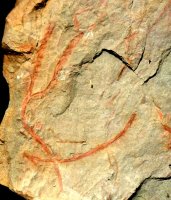 The
genus Zosterophyllum serves as a model for a large group of plants,
the Zosterophylls, into which also the first two plants of this chapter,
Gosslingia and Sawdonia, are included. This group was in existence
from the Late Silurian until the Late Devonian and is narrowly related to
the lycopods, which includes Drepanophycus. An important characteristic
of the Zosterophylls is the fact that the sporangia are laterally borne along
the stem (and not at the end like in Cooksonia). In many cases they
form a kind of a spike. Furthermore the growing tips of the stems are coiled
(like young ferns). Click on the photo to see a larger photo and a reconstruction
of the plant. The
genus Zosterophyllum serves as a model for a large group of plants,
the Zosterophylls, into which also the first two plants of this chapter,
Gosslingia and Sawdonia, are included. This group was in existence
from the Late Silurian until the Late Devonian and is narrowly related to
the lycopods, which includes Drepanophycus. An important characteristic
of the Zosterophylls is the fact that the sporangia are laterally borne along
the stem (and not at the end like in Cooksonia). In many cases they
form a kind of a spike. Furthermore the growing tips of the stems are coiled
(like young ferns). Click on the photo to see a larger photo and a reconstruction
of the plant.
The name Zosterophyllum comes from Penhallow, who gave it in
1892 to plant remains resembling sea grass (in Latin:
Zostera). The meaning of the name is therefor: plant with sea
grass-like leaves.
We made our own finds mainly in the old quarries in het region of Forfar
in Scotland. The rock in some of the quarries is full of long, bent plant
stems. Sometimes they lie more of less parallel, but mostly they in a jumble.
There is little structure to see and branching stems are very rare. I know
from the literature that the plant is named Zosterophyllum myretonianum,
but identifying one yourself is hardly thinkable. As so often in Lower Devonian
plants, scientists need the very rare , complete specimens to know more about
a plant. That's why I was very happy to find the spore cone on the photo
above.
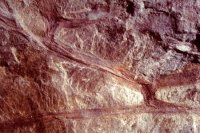 Click on
it. Click on
it.
I have found the coiled tips of the stems only as loose spirals.
Striking are the H- and K-shaped branchings. It is assumed that these
are part of a ground network of horizontally growing stems, which are attached
to the soil by hair roots. Such branchings are not present in upright stems,
moreover the vertical stems branch very rarely. Click on the photo on
the right.
Within the genus Zosterophyllum eight species have been described,
differing from each other in details. |
Conclusion
Reconstructions of Lower Devonian plants are generally achieved with
difficulty because the fossils are usually fragmentary. Often many paleobotanists
were involved and their insights have changed in the course of 150
years or in any case they have become more specific. Collecting this kind
of plants is difficult and time-consuming but by the same token it gives
a lot of satisfaction when you manage to get an image of the complete plant.
It provides a glance at a world of plants which is quite different from the
present one.
Literature
Top |
|